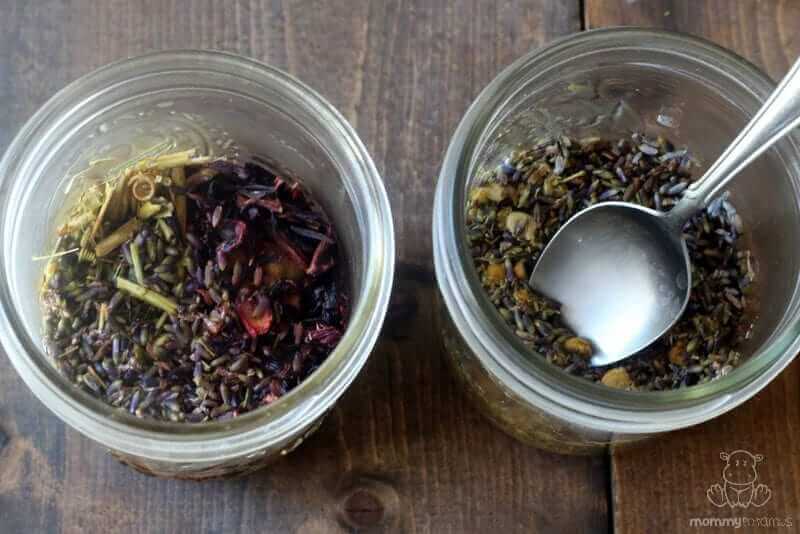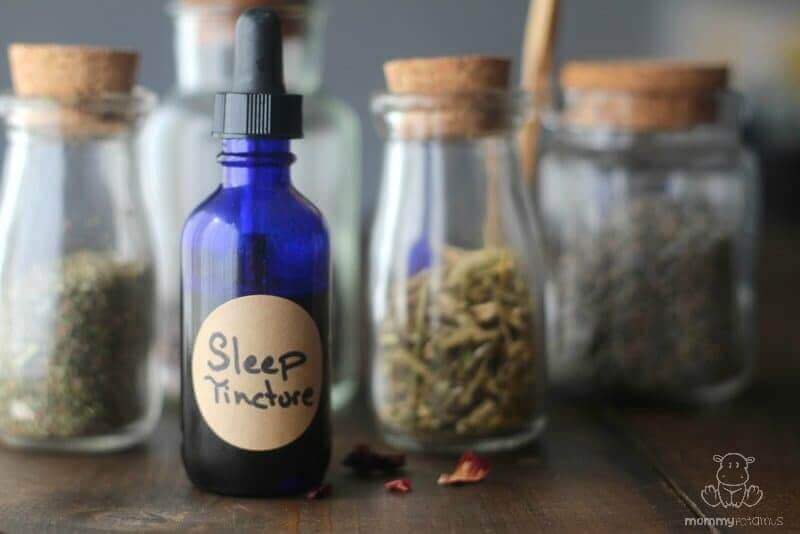“Parenthood sharpens your math skills because you spend all night calculating how much sleep you’ll get if you fall asleep RIGHT NOW.” ~ Unknown
My husband used to joke that if sleep were an Olympic sport, I would be a three-time gold medal winner. And then we had kids.
Now, I’m really, REALLY glad for that, but it pretty much crushed my imaginary career. Goodbye sleep athlete – hello mommy zombie!
Fortunately, thanks to the tips I shared in this post and this post, both the little potami and I are sleeping so much better. Another tool I’ve found helpful in my career comeback is this sleep tincture recipe. It uses calming herbs that are generally considered beneficial for adults and children, which I love because it can be used by our whole family.
Why use a sleep tincture?
1. Simplifies the bedtime routine
Although bedtime tea is a lovely way to wind down, if your family is anything like mine there are nights when you are rushing to get the littles to bed on time. Sleep tinctures can be made in advance with just a few minutes of active prep time, then given before bed without the hassle of boiling water, adding the tea and waiting for it to cool.
2. Makes travel easier
Both from a packing standpoint (think loose leaf tea scattered throughout your suitcase) and a time-zone standpoint (jet lag, anyone?), sleep tinctures are a great way to relax on the road.
3. Reduces trips to the bathroom and/or accidents
If you’re pregnant and your bladder has shrunk to the size of a pea, you may find that a big cup of tea before bed is not your friend. Likewise, little ones that are still learning to control their bladder at night may prefer a tincture instead of tea.
Why these herbs?
Though there are several more herbs – lemon balm, for example – that are thought to have a positive effect on sleep, the herbs in the two tincture recipes below are favorites of the potami. Not surprisingly, they’re the same ones that are used in my Sweet Dreams Tea recipe. As I mentioned in that post:
Catnip, chamomile, and passion flower are all gentle, kid-safe herbs with mild sedative qualities. In addition to their popularity among herbalists and even children’s books (remember how Peter Rabbits mom used to put him to bed with chamomile tea?), these herbs are now making their way into research.
According to this PubMed review, the sedative effects of chamomile may be due to a flavonoid called apigenin, while this study found that passion flower improved sleep quality when taken as a tea before bed.
Though not considered a sedative, one study showed that lavender’s aroma improved sleep in individuals suffering from insomnia. When brewed as a tea, lavender buds release their aroma while adding flavor.
Sweet licorice root and fruity passion flower are also included for flavor –
Why glycerin?
Though alcohol based extracts are most common, glycerin is often preferred for use with children. Glycerin-based extracts are not quite as strong as alcohol-based ones, but I can say from personal experience that they are usually strong enough. Since I like to keep things simple, I usually opt for a family-friendly tincture option that everyone in the home can use. That’s definitely the case for these recipes, although I use a couple more dropper full’s for myself than the potami.
Another option is to use apple cider vinegar, but in my experience glycerin is a better option because it’s sweet. If you forget to give it to your littles, chances are they will remind you!
(Pssst. For those who sometimes need a little extra help winding down – Daddypotamus, for example – a more potent tincture can be made with alcohol and valerian root. It’s just for grownups – recipe coming soon!)
How I Use This Tincture
I usually use 1-2 droppers full (about 1ml per dropper) for the two older potami (ages 5 and 7), one-half a dropper for my toddler, and 3-4 droppers for myself, often mixed in a little water.
Just like with food, I rotate the herbs and tinctures we use so that our diet includes a variety of micronutrients without too much of any particular compound. Until the refrigeration era we automatically ate seasonally available foods, but now it is something I am purposefully mindful of.

Deep Sleep Tincture Recipe
Makes about 1 cup. Shelf-life is approximately 14-24 months if stored in the fridge.
Chamomile & Licorice Flavor
This mild, licorice-flavored blend incorporates three calming herbs: catnip, chamomile and lavender.
- 3 tablespoons catnip (where to buy catnip)
- 4 tablespoons chamomile flowers (where to buy chamomile flowers)
- 3 tablespoons lavender blossoms (where to buy lavender blossoms)
- 1 teaspoon licorice root (where to buy licorice root)
- 1/2 cup boiling water
- 1 cup food grade glycerin (where to buy glycerin)
Fruity Hibiscus Flavor
This aromatic, slightly fruity blend has a beautiful, ruby-colored hue.
- 2 tablespoons hibiscus flowers (where to buy hibiscus flowers)
- 1 tablespoon lavender blossoms (where to buy lavender blossoms)
- 3 tablespoons catnip (where to buy catnip)
- 3 tablespoons chamomile (where to buy chamomile flowers)
- 2 tablespoons passion flower (where to buy passion flower)
- 1/2 cup water
- 1 cup food grade glycerin (where to buy glycerin)
Quick Method
The method is the same as this one for plaintain “first aid” salve, only we’re using dried herbs instead of fresh. Though the slow method below is considered the gold standard of infusions, sometimes you just can’t wait six weeks. For those times, this slow cooker method is ideal. I use it often with great results.
Equipment Needed
- 1 pint jar
- 8 quart slow cooker (if you have a smaller slow cooker you may need to use smaller jars)
- Mesh strainer or cheesecloth
Instructions

- Add herbs to a pint-size mason jar.

2. Pour in boiling water and mash down the herbs with a spoon until they are all slightly damp.

3. Add in glycerin.

4. Cover jar with a lid, then place in a slow cooker that has been lined on the bottom with a dish towel. Pour in water until about half the jar is submerged, then turn the slow cooker on warm and cover. Let sit for 18-24 hours. If desired, remove the jar a few times a day and shake to release the beneficial properties of the herbs.

5. Remove jar from slow cooker and strain the liquid through cheesecloth or a fine mesh sieve, then pour into a clean jar or dropper bottle and add a label. Store in the fridge until needed.
Slow Method
1. Place herbs in a clean, dry pint mason jar and pour in boiling water.
2. Add in the glycerin and give the mixture a good stir.
3. Place in a dark cabinet and shake once a day for 12-14 days, then allow to rest in the cabinet for 2-4 additional weeks.
4. Strain the liquid through cheesecloth or a fine mesh sieve, then pour into a clean jar or dropper bottle and add a label. Store in the fridge until needed.
Want more research-backed natural remedies?
No problem, I’ve created a free ebook for you – Kitchen Apothecary: 25+ Natural Remedies Using Ingredients From Your Pantry – as a gift for signing up for my newsletter. You’ll also get updates when I post about safe essential oils for pregnant/breastfeeding mamas, exclusive gifts and coupons (I was able to give away a jar of free coconut oil to anyone who wanted it recently!), plus other goodies.
Sign up using the form below.





